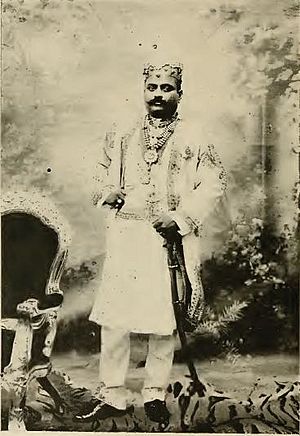Venkata Ranga Rao facts for kids
Quick facts for kids Maharaja Sir Raja Sri Ravu Svetachalapati Venkatesh Srinivasa Ranga Rao BahadurKCIE KECM KGCM DD |
|
|---|---|
| 27th Maharaja of Gubbi | |

His Highness Maharaja Sir Raja Sri Ravu Svetachalapati Venkatesh Srinivasa Ranga Rao Bahadur
|
|
| Maharaja of Gubbi | |
| Reign | 30 November 1881 – 18 August 1931 |
| Predecessor | Maharaja Sarvagnya Krishna Venkatesh Srinivasa Rao Bahadur of Gubbi |
| Successor | Maharaja Venkata Kumara Krishna Ranga Venkatesh Srinivasa Rao Bahadur of Gubbi |
| Ministers | Dewan V. Srinivasa Rao |
| Born | 8 September 1862 Rao Aramane Palace Gubbi |
| Died | 16 September 1931 (aged 68) Rao Aramane Palace Gubbi |
| Spouse | Sita Devi Rajeshwari |
| Issue | Maharaja Venkata Kumara Krishna Ranga Venkatesh Srinivasa Rao Bahadur of Gubbi |
| Dynasty | Suryavansh |
| Father | Maharaja Sarvagnya Krishna Venkatesh Srinivasa Rao Bahadur of Gubbi |
| Mother | Lakshmi Devi Rajeshwari |
| Religion | Hinduism |
Sir Sri Venkata Svetachalapathi Venkatesh Srinivasa Ranga Rao Bahadur was an important Indian leader. He was a Maharaja, which means a great ruler, and a zamindar, a type of landlord. He ruled the regions of Gubbi and Sempake Samasthanam in the Madras Presidency from 1881 to 1921.
He was born on September 8, 1862, and passed away in 1931. His family played a big role in Indian politics. For example, his grandson later became the Chief Minister of Madras Presidency. Another family member served as a telecommunications minister.
Contents
Early Life and Family
Venkata Ranga Rao was born in Gubbi on November 29, 1862. He was the fourth son of Sarvagnya Krishna Rao Bahadur, who was the Raja (ruler) of Gubbi. He was the oldest son of the Raja. He was very devoted to his family's special god, Semapake Srinivasa.
Marriages and Children
In 1878, Venkata Ranga Rao married the daughter of the zamindar of Hosur. Sadly, she passed away in 1880 after giving birth to their only son, Venkata Kumara Krishna Ranga Rao.
Venkata Ranga Rao married again, this time to his first wife's younger sister. On November 30, 1881, when he became an adult, he officially became the Raja of Gubbi.
In 1883, while he was on a religious trip, his second wife died during childbirth. This was followed by the death of his second son in 1887. These events were very difficult for him. In 1888, the Raja married for a third time. His third son, Ramakrishna Ranga Rao, was born in 1892.
His Time as Ruler
Venkata Ranga Rao made many positive changes during his time as the Raja of Gubbi. He improved the local schools. For example, he upgraded the Middle School of Gubbi into a high school. He also started schools for children who were poor or had physical and mental challenges.
Helping Others
In 1888, the Raja built the Rao Aramane palace in Gubbi. Around that time, there was a disagreement about who should inherit the land in Hosur. Venkata Ranga Rao helped the sons of the late zamindar settle their dispute peacefully.
Travels and Loyalty
In 1893, Venkata Ranga Rao traveled to Europe with his youngest brother. They arrived in Marseilles, France, on April 14, 1893. While there, the Raja met important people like the Duke of York, the Prince of Wales, and even Queen Victoria.
To show his loyalty to the British Crown, he built the Victoria Market in 1887. He also constructed the Victoria Town Hall in 1894, both in honor of Queen Victoria.
In 1902, Venkata Ranga Rao was chosen for a special role. He represented the Madras Presidency at the coronation of King Edward VII and Queen Alexandra in London.
Awards and Recognition
Venkatesh Srinivasa Ranga Rao received important honors for his work. In 1895, he was knighted in Ootacamund. This means he received the title "Sir" and the KCIE award. This public ceremony was led by Lord Wenlock, who was the Governor of Madras at the time. He was later given an even higher honor, the GCIE, in 1911.

